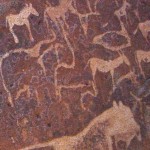Twyfelfontein
Archaeology »
Heritage sites»
Twyfelfontein
Location
Kunene
Country
Namibia
Year of Research
2007
Culture
Twyfelfontein or /Ui-//aes has one of the largest concentrations of rock petroglyphs (engravings) in Africa. Most of these well-preserved engravings represent rhinoceros, elephant, ostrich and giraffe, as well as drawings of human and animal footprints. The site also includes six painted rock shelters with motifs of human figures in red ochre. The objects excavated from two sections, date from the Late Stone Age. The site forms a coherent, extensive and high-quality record of ritual practices relating to hunter-gatherer communities in this part of southern Africa over at least 2,000 years, and eloquently illustrates the links between the ritual and economic practices of hunter-gatherers.The rock art engravings and paintings in Twyfelfontein form a coherent, extensive and high quality record of ritual practices relating to hunter-gather communities in this part of southern Africa over at least two millennia.The rock art reflects links between ritual and economic practices in the apparent sacred association of the land adjacent to an aquifer as a reflection of its role in nurturing hunter-gather communities over many millennia.The integrity of the property is generally intact. The Twyfelfontein Country Lodge was permitted by the Conservancy in 1999/2000 within the Seremonienplatz rock engraving site in the buffer zone. This has severely compromised the integrity of the rock engravings in this area.

